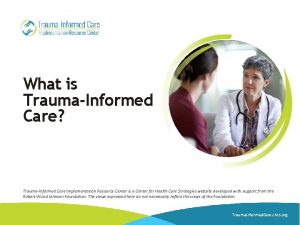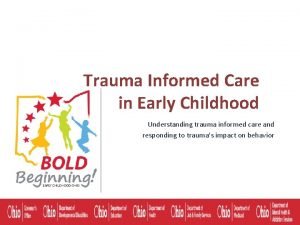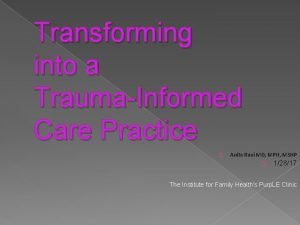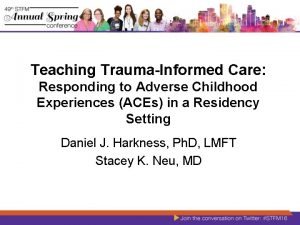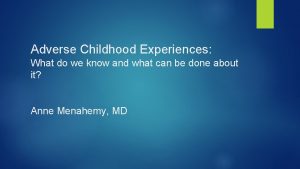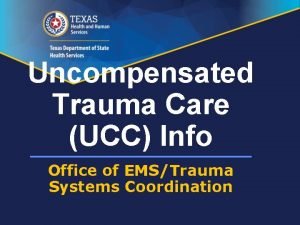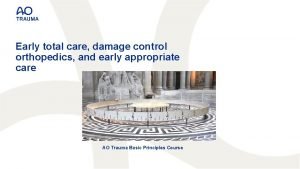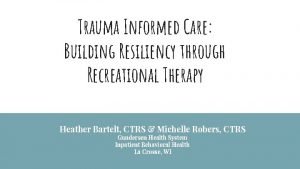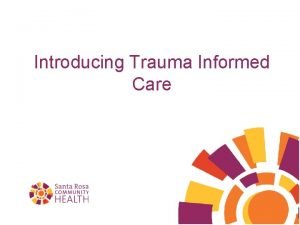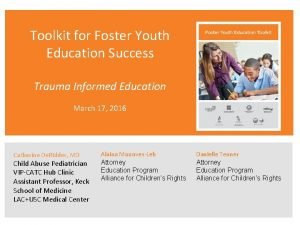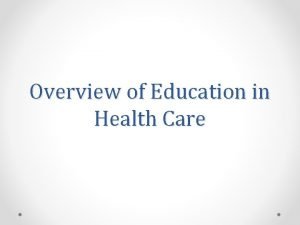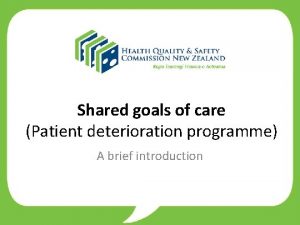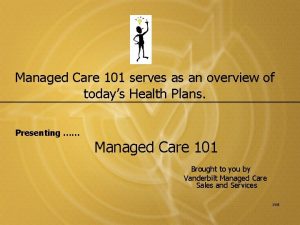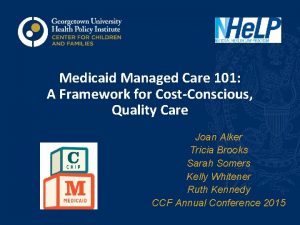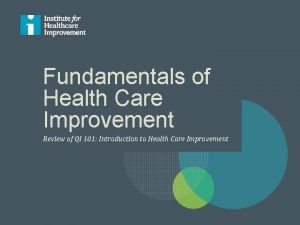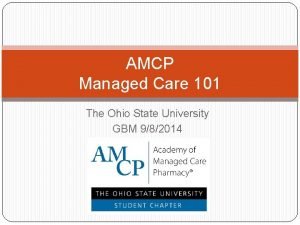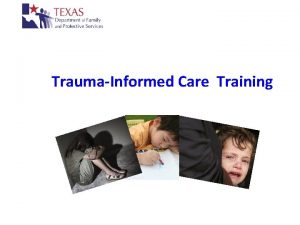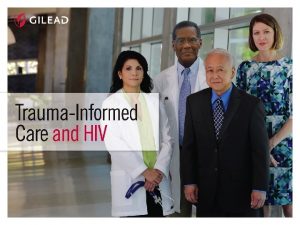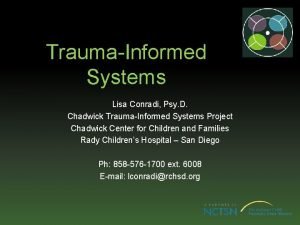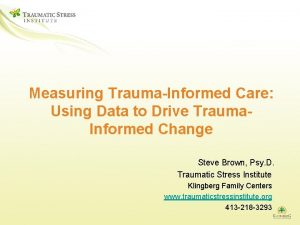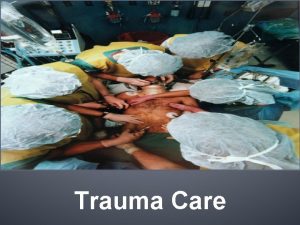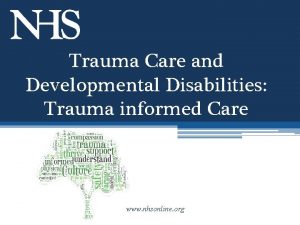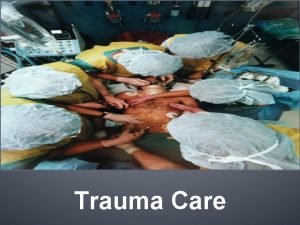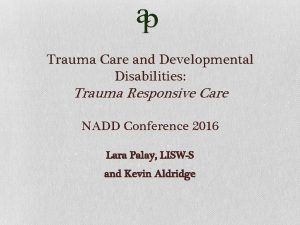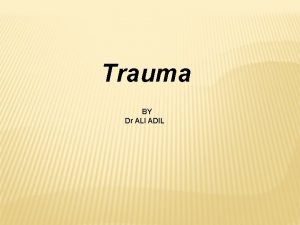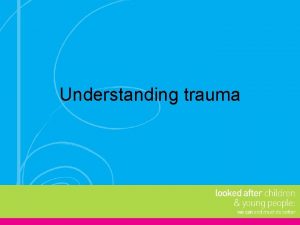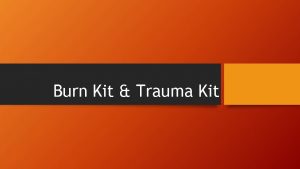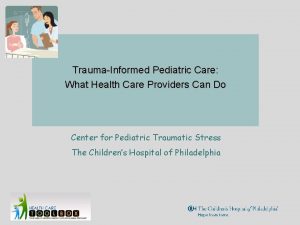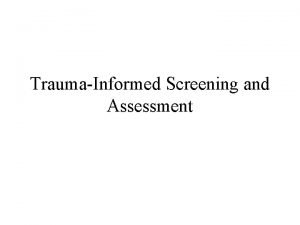Trauma 101 An Overview of TraumaInformed Care Goals

































- Slides: 33

Trauma 101 An Overview of Trauma-Informed Care

Goals Connect colleagues Enhance and enrich awareness and knowledge of trauma Develop a shared language Increase awareness of Adverse Childhood Experiences Study Learn basics of brain growth and impact of toxic stress Understand four components of Trauma-Informed Care Embrace reasons for hope

Predictions, Acknowledgments and Disclaimers Most of the information and research on traumainformed care is new. Information may be a review or it may be a new experience. Learning about trauma may be painful. We encourage each participant to mentally create a Safety Plan. There is more to know about trauma than we can present.

Safety Plan is a list of simple external and internal activities that a person can choose to use when feeling triggered or overwhelmed. Mentally consider what promotes your safety: • externally (i. e. sit near door, doodle, walk out) • internally (i. e. self-awareness, self-talk, reassure yourself that you are competent and capable of maintaining your safety)

Ground Rules Because we will be interactive, we ask that everyone be mindful about maintaining a safe environment for discussion. Respect all opinions. Share air space. Be question sensitive. Preserve confidentiality. Be self-protective. Limit side conversations (including technology).

ACEs Research How many of you know about the ACEs Research? Dr. Nadine Burke-Harris Ted. Talk: Dr. Burke-Harris received a medical degree at UC Davis and a Masters in Public Health from Harvard. In 2015 she worked at California Pacific Medical Center where she developed programs to address health disparities in the San Francisco Bay Area. http: //www. ted. com/talks/nadine_burke_harris_how_childho od_trauma_affects_health_across_a_lifetime


ACEs in Philadelphia According to Dr. Roy Wade, a local pediatrician, researcher and member of the Philadelphia Task Force: “When we looked at how common ACEs were across Philadelphia, we found the highest prevalence in the 22 nd police district with almost 60% of the respondents from this area stating they had experience four or more ACEs growing up. We know that there are higher rates of health and social problems clustering in the 22 nd district. Our research suggests that early childhood stress could explain the high occurrence of these conditions in the 22 nd district neighborhoods. ” October 2015 Presentation for the New Eyes Video

The Value of Knowing About ACEs Appreciating the impact of ACEs is one key piece of understanding trauma In addition to ACEs, we can consider the impact of a variety of other traumas and chronic toxic stress

What is Trauma? An overriding emotional event involving deep distress, alarm, fear or terror “Neuro-electrical jolt” The event is perceived as inescapable And/or sustained, toxic stress, also inescapable Neurological landscape changes – Powerful sensory memories are created which lead to: Fight Flight Freeze Capitulation

Principles of Trauma Everyone has different responses, depending on their history of trauma, support, degrees of resilience and temperament Some trauma resolves on its own Some trauma remains dormant until triggered Post Traumatic Stress (PTS) – high degree of stress for several days or weeks after a significant trauma Post-Traumatic Stress Disorder (PTSD) – stress symptoms are present three months after event

Complexity “The experience of trauma is complex. Trauma varies in type, source, chronicity, and impact; it is experienced at different developmental stages, within different context – family, community, and culture – and in the presence or absence of different internal and external resources and challenges. It is not surprising, then, that disparity exists in our understanding of trauma in its manifestations, and in its proper treatment. ” Source: Treating Traumatic Stress in Children and Adolescents by Blaustein and Kenniburgh

Early Brain Development Nurturing, responsive and individualized interactions from birth build healthy brain structure Healthy brain architecture is the necessary foundation required for optimal future learning, behavior and health Regional Child Abuse Prevention Councils 2011

Key Brain Basics Human brain consists of about 84 billion neurons. Each neuron forms about 1, 000 connections. One billion synapses in 1 cubic inch of brain tissue. 403 billion glia cells in each brain. 420 trillion synaptic boutons. 8. 4 quadrillion synaptic proteins 2. 5 quadrillion neuronal/brain cell interactions (electrical conversations) per minute. Source: Dr. Bruce Perry • April 20, 2015

Stress and the Brain Excessive and repeated stress: Neglect, violence Chaos, unpredictability Hostility, rejection Causes disruption of brain architecture: Impairs cell growth Interferes with healthy neural circuits Regional Child Abuse Prevention Councils 2011

The Theory of Everything “Scientists are calling the correlation between childhood trauma, brain architecture, and adult well-being the new psychological ‘theory of everything. ’” “Adverse Childhood Experience research shows that both physical and emotional suffering are rooted in the complex workings of the human immune system… What happens to the brain in childhood sets up the lifelong programming for this master operating system, governing all: body, brain, and mind. ” “The unifying principle of this new ‘theory of everything’ is this: your emotional biography becomes your phsycial biology. . . Your early stories script your biology and your biology scripts the way your life will play out. ” Source: Childhood Distrupted: How Your Biography Becomes Your Biology and How You Can Heal by Donna Jackson Nakazawa, 2015.

Amygdala Small almond-sized structure One on either side Part of limbic system Acts as sentry or router Processes incoming data, especially as it relates to danger, fear or pain Decides where in the brain to send information

Amygdala Amazing ability to store sensory memories, especially as related to danger, fear and pain Can be activated (triggered) in as little as 1/12 th of a second, ordering the brain to release powerful neuro-chemicals (brain hormones) so body is ready to fight, flee or freeze “Hijacks” the brain

Amygdala Overwhelming moments of deep fear or terror, ACEs or chronic, toxic stress transform healthy amygdala (sentries) into ones that are hyper-sensitive, easily agitated and prone to signaling the brain to release toxic levels of neurochemicals. The child or adult with overly-reactive amygdala can lead to a host of problems: Hyper-arousal Hyper-aggression Dissociation Inabilities to concentrate Health problems

Amygdala The brain actually becomes inflamed from all of the excess stress hormones/neuro-chemicals surging through it. This over-sized, reactive amygdala can lead to all the physical, mental, emotional and social problems described in the ACEs research.

Kinds of Trauma • Situational OR Relational • Medical Trauma • Acute/Single Event • War Trauma • Chronic Trauma • Vicarious Trauma • Complex Trauma • Unprocessed Memories • Chronic Toxic Stress • Allostatic Load • Adverse Childhood Experiences (ACEs) • Developmental Trauma • Attachment-Related Trauma • Transgenerational Trauma • Cultural/Political Trauma • Community Traumas • Occurred in the past vs currently being experienced


PART Prevention: ensuring to whatever degree is possible that traumatizing events are prevented from occurring in the first place Avoid triggering or otherwise exacerbating existing trauma-related issues and needs Respond appropriately and in trauma-informed ways if Therapeutic processes that can promote recovery and healing of trauma-related issues and needs.

Why there is Hope Research is providing clearer information, provides scientific evidence of the impact of trauma, violence, ACEs. There are trauma-sensitive responses that can change outcomes for the better. The brain is capable of being changed.

Trauma-Sensitive Therapies and Programs Somatosensory Activities Yoga / Mindfulness Art & Music Therapy EMDR (Eye-Movement Desensitization Reprocessing) TFCBT (Trauma-Focused Cognitive Behavioral Therapy) Dr. Sandra Bloom’s Sanctuary Model Dr. Bruce Perry’s Neurosequential model IFP’s Trauma Courses and Trauma-Competent Certification Process

Hope Schools and other systems that impact children and families can become brain-based with staff that is trauma-informed Schools and other systems can incorporate the principles and practices that: Prevent ACEs, trauma and toxic stress Avoid triggering and exacerbating trauma Respond to students and others in effective ways when they are triggered provide Therapeutic interventions that promote healing

Post-Traumatic Growth A positive change experienced as a result of the struggle with a major life crisis or a traumatic event. Human beings can be changed by their encounters with life challenges, sometimes in radically positive ways. Source: https: //ptgi. uncc. edu/what-is-ptg

Post-Traumatic Growth 300 studies since 1990 70% report positive psychological growth 1. New Opportunities 2. Closer Relationships 3. Stronger 4. Greater Appreciation for Life 5. Spiritual / Religious Source: The Huffington Post: The Surprising Benefit of Going Through Hard Times 01/02/2016

The Single Most Significant Component of Healing …is experiencing healthy relationships. According to Neurons to Neighborhoods: “Human relationships, and the effects of relationships on relationships, are the building blocks of healthy development. ” “Healing takes place in the context of healthy relationships over time. ”

Reframe Instead of asking, “Whats wrong with you? ” Trauma-informed people ask, “What happened to you? ” Joseph Foderaro Psychoeducation Training Specialist Drexel University College of Medicine

Continuum of Sophistication with Regard to Trauma Education ü Provides a panoramic view of nature of trauma education ü Serves as a construct to enhance overall awareness and understanding ü Not everyone needs to advance along continuum ü Each area represents knowledge levels in multiple traumarelated domains ü As people move along continuum they become increasingly better equipped to meet trauma-related needs ü Non-clinical model to bring levels of trauma education to large numbers of people who impact children and families

Continuum of Sophistication Training Time Needed Trauma. Aware Trauma. Informed Trauma. Sensitive Trauma. Competent 2 -4 hours 12 -15 hours 40 -50 hours 120+ hours (Six 2. 5 hour sessions with outside reading) (Additional twelve 2. 5 hour sessions with outside reading and practicum work) (approximate) General overall trauma knowledge Basic awareness Gained more sophisticated information Becoming more sensitive Ever-growing knowledge and skill base Degrees of appreciation for current models Introduction to the concept that there are several models Enhanced awareness and understanding of specific approaches Increased awareness and understanding of somatosensory approaches Greater awareness and understanding of somatosensory approaches and related skills

Resources Institute for Family Professionals www. ifpros. net United Way of Greater Philadelphia and Southern New Jersey Suzanne O’Connor soconnor@uwgpsnj. org or 215 -665 -2453
 Traumainformed care
Traumainformed care Strategic goals tactical goals operational goals
Strategic goals tactical goals operational goals Strategic goals tactical goals operational goals
Strategic goals tactical goals operational goals Emt chapter 24 trauma overview
Emt chapter 24 trauma overview Levels of care primary secondary tertiary quaternary
Levels of care primary secondary tertiary quaternary 4 r's trauma informed care
4 r's trauma informed care Lgbt trauma informed care
Lgbt trauma informed care Anita ravi md
Anita ravi md Trauma informed approach
Trauma informed approach 4 r's trauma informed care
4 r's trauma informed care Www.dfps.state.tx.us/training/trauma informed care/
Www.dfps.state.tx.us/training/trauma informed care/ Tina champagne sensory modulation
Tina champagne sensory modulation Uncompensated trauma care application texas
Uncompensated trauma care application texas Total care orthopedics
Total care orthopedics Trauma-informed care cheat sheet
Trauma-informed care cheat sheet Trauma informed icebreakers
Trauma informed icebreakers Trauma informed care for foster youth
Trauma informed care for foster youth General goals and specific goals
General goals and specific goals Motivation in consumer behaviour
Motivation in consumer behaviour Example of nursing process
Example of nursing process Goals of care alberta
Goals of care alberta Shared goals of care
Shared goals of care Anxiety goals for nursing care plan
Anxiety goals for nursing care plan Managed care 101
Managed care 101 Ihi l101
Ihi l101 Managed care 101
Managed care 101 Health care 101
Health care 101 Qi 101: introduction to health care improvement
Qi 101: introduction to health care improvement Osu amcp
Osu amcp Duty of care certificate
Duty of care certificate Acul magnetic al unei busole se orienteaza
Acul magnetic al unei busole se orienteaza Palliative care versus hospice care
Palliative care versus hospice care Se inmultesc prin oua
Se inmultesc prin oua Care sunt simturile prin care sunt evocate
Care sunt simturile prin care sunt evocate
